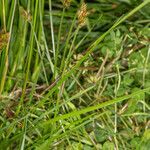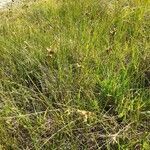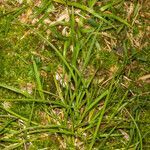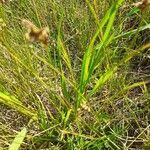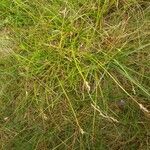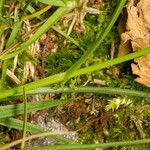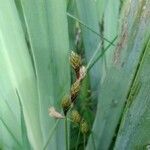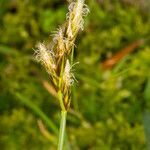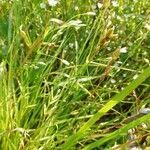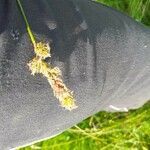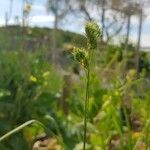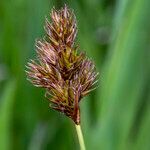Rhizome not seen. Culms slender, 50-80 cm tall, 0.8-1 mm thick, trigonous, smooth below, scabrous above, leaflike near base. Leaves 3 or 4, flat, ca. 1.5 mm wide, much shorter than culm, margins scabrous. Involucral bracts glumelike, lowest long awned. Inflorescence 2-2.5 × 0.8-1.3 cm; spikes 4-7, gynaecandrous, brown, ovate to oblong, 5-10 × 3-6 mm, contiguous, sessile. Female glumes yellowish [or reddish] brown, ovate, ca. 3 × 1.5 mm, 1-veined, with pale yellow midrib and broadly hyaline margins, apex acute. Utricles light brown, ovate, plano-convex, 3.5-4 × 1-1.5 mm, smooth, 4-6-veined abaxially, rather broadly winged from shoulder to top, margins scabrous near top, spongy-thickened below, beak ca. 1 mm, deeply bifid abaxially. Nutlets brown, obovoid-oblong, compressed biconvex, ca. 2 × 1 mm, smooth, slightly shiny, shortly beaked and stipitate; stigmas 2. Fr. Aug. 2n = 66, 74.
More
Tufted, erect, 3–8 dm; main lvs 2–4 mm wide, shorter than the stems; spikes 3–7, gynaecandrous, ovoid, 1 cm, sessile and closely crowded; pistillate scales ovate, reddish-brown with broad hyaline margins, largely concealing the perigynia; perigynia 4–5.5 mm, 2–2.5 times as long as wide, plano-convex, narrowly scarious-margined, finely but sharply nerved on both sides, the beak distally terete, reddish-brown at the tip; achene lenticular, 1.5–2 mm; 2n=64, 66, 68. Native of Eurasia, intr. in wet meadows and pastures from Nf. to N.Y. and reputedly to N.C. (C. ovalis)
Rough grassy places on acid soils. Wet meadows and bog margins, although exceptionally it can grow on psychoxerophilic meadows; tolerates soil nitrification well; at elevations from 50-3,400 metres.
